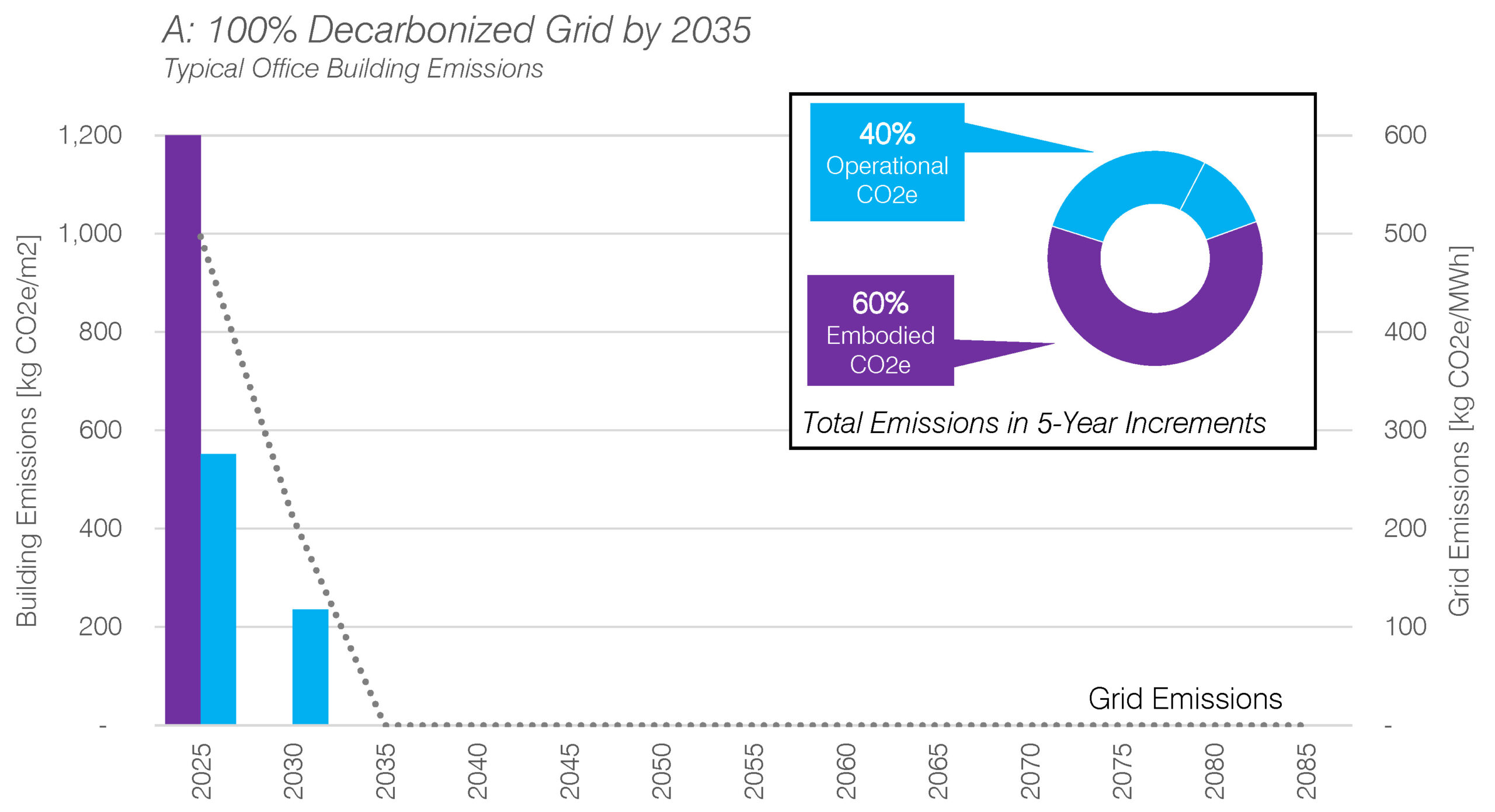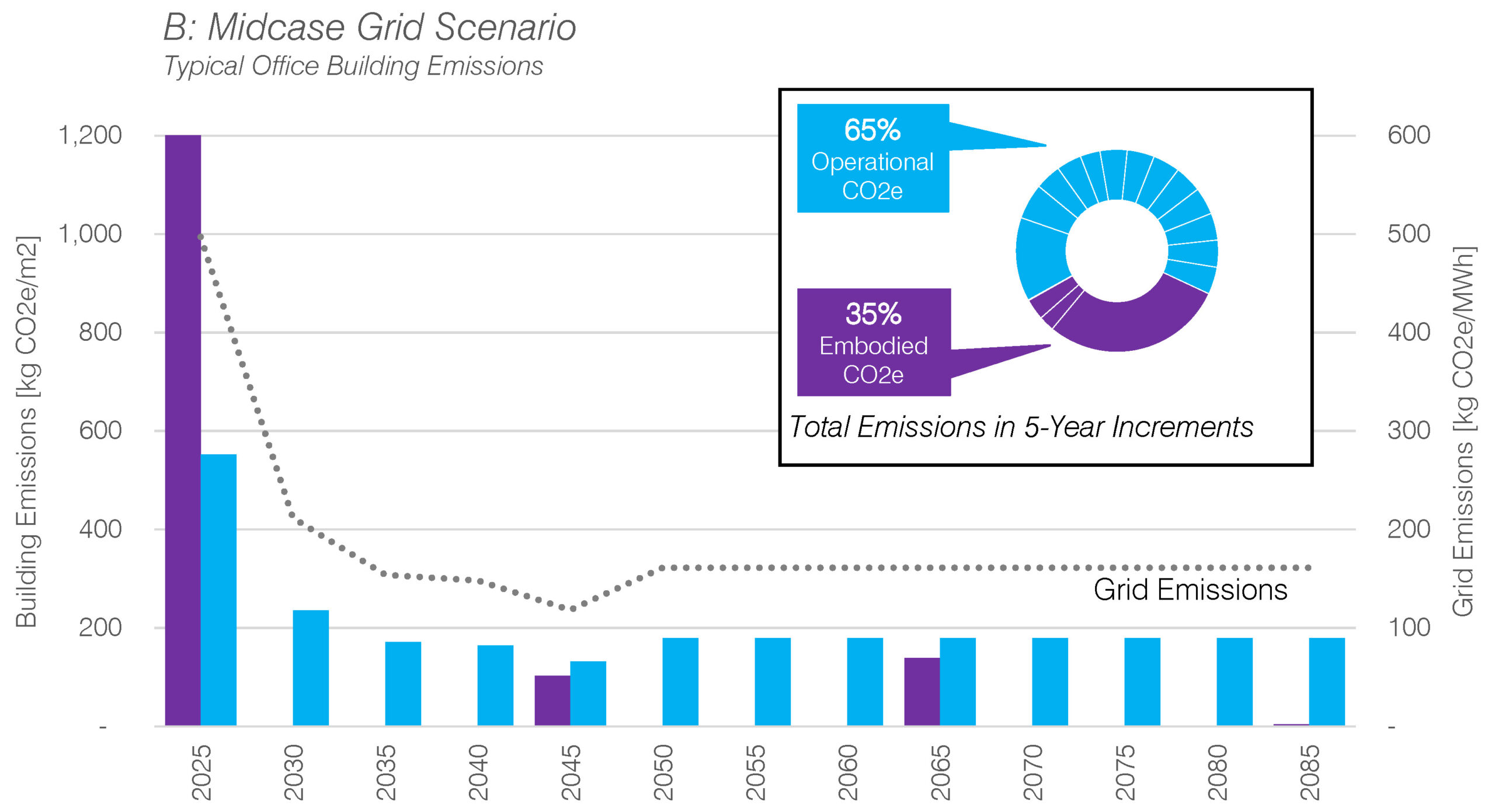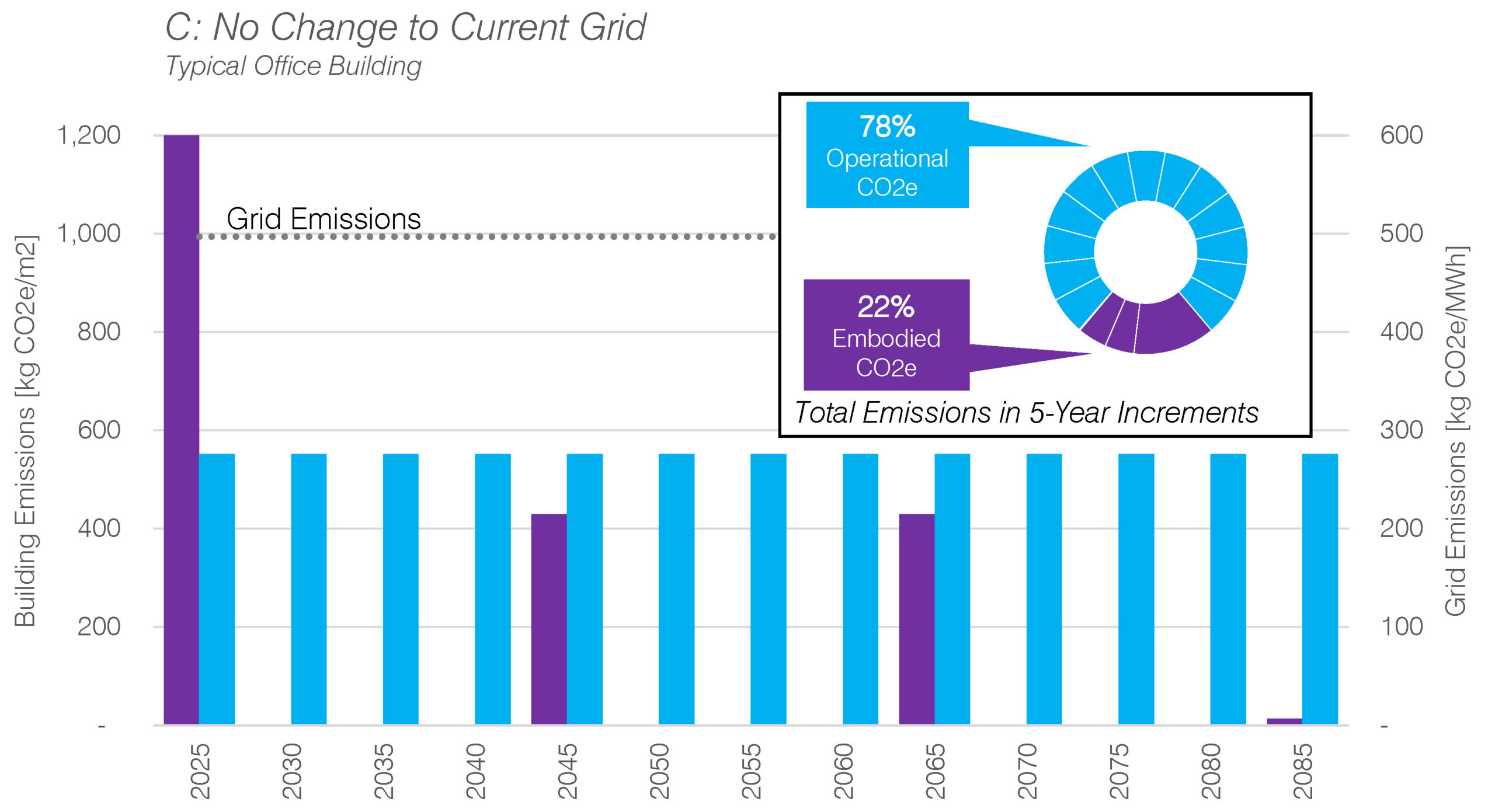LAB
How future grid scenarios are shaping architectural design
Originally published in arcCA Digest, a publication of the AIA California
Season 18, September 2024.
I recently consulted on a building where the design team worked hard to quantify all possible greenhouse gas emissions associated with the project. We examined the carbon emissions embodied in the manufacture, transportation, and maintenance of the building materials (embodied CO2) as well as the future carbon that would be emitted by operating the lights, HVAC systems, hot water, appliances, and plugs over the projected 60-year lifespan of the building (operational CO2). The lifecycle assessment was intended to help guide a progressive developer in making decisions that would have the greatest impact on greenhouse gas emissions while also accounting for cost, constructability, schedule, etc. Because there was a fixed budget, we hoped that the carbon accounting would help the design team prioritize the most important things. The result surprised me.
When considering the impact of aluminum sunshades, the analysis showed that the embodied carbon of the aluminum would be greater than the sunshades’ operational carbon savings from decreased air conditioning. The conclusion hung on an industry-standard scenario that the energy grid will be substantially de-carbonized by 2035 and therefore the electricity used for air conditioning would have only marginal carbon impacts over the course of the building’s 60-year life. This seemed like an overly optimistic assumption, and moreover, the analysis pointed us in a direction that was a decidedly narrow way of seeing architecture in general. In this article I will show how the sanctioned approach to quantifying carbon emissions is leading building professionals to privilege embodied carbon to the detriment of the buildings and the environment. In any realistic future, operational carbon is just as important, if not more important, than embodied carbon. What’s more, the building strategies and components that reduce operational carbon also make for more resilient buildings that are better prepared to adapt to climate change, reduce operating and infrastructure costs, and just plain make for better buildings with happier occupants.
The assumption of a de-carbonized grid is driven by history, economics, and policy in interesting ways. Since fracking became a cost-effective technology in the late 2000’s, natural gas power plants have quickly replaced coal as the predominant energy generator across the US. Because natural gas emits fewer greenhouse gases than does coal, the grid as a whole emits less CO2. The 2022 Inflation Reduction Act set economic policies in motion that are intended to extend and intensify this trend. The Congressional Budget Office predicts an eye-opening 60% reduction in grid emissions between 2022 and 2032.
This one assumption accounts for much of the difference between the amount of embodied carbon in the aluminum sunshade and the operational carbon it would prevent. While a decarbonized grid is great news for everyone outside the fossil fuel industry, the presumption of vast grid improvements is as precarious as the next election or the next disruptive technology. What happens if these policies are not as effective as intended? Is the future we’ve been planning thrown out the window? Probably, and that means that we need to consider multiple futures. As if architecture weren’t hard enough, right?
Annual Emissions of Carbon Dioxide From the Electric Power Sector in Billions of Metric Tons. Source: Congressional Budget Office, “Emissions of Carbon Dioxide in the Electric Power Sector.” Dec 2022: https://www.cbo.gov/publication/58860
We can hope and strive for a zero-emissions grid but it would be foolish to count on it. And yet, the presumption of a near zero-carbon grid underlies almost all studies of future carbon emissions and biases the results. Design teams have started prioritizing embodied carbon over operational carbon, but if the idealized future does not come to pass, we will be responsible for a massive wave of compounding and avoidable emissions.
Consider the three scenarios shown in the following figures: (A) an idealized grid that is completely decarbonized by 2035, (B) a commonly accepted midcase scenario with 68% reduction in grid carbon by 2050, and (C) a grid that is stuck indefinitely at current grid emissions levels. For all three, I’ve modeled a “business as usual” office building constructed in 2025 with renovations in 2045 and 2065, and an end-of-life in 2085. The initial construction materials and activities emit 1200 kg CO2e / m2 and the first five years of operations emit 550 kg CO2e / m2. These numbers describe a poorly performing building with much room for improvement. The question for us as architects: where should we put limited time and money for design improvements?
In the first scenario, building emissions plunge to zero in the first 10 years, following the grid. In this best-case future, there is a 60/40 split between embodied and operational carbon. As an architect, I might concentrate on the low-hanging fruit – such as reducing concrete or right-sizing the HVAC system. But that aluminum sunshade is not going to appreciably move the needle on the building’s carbon footprint since the emissions will disappear in a decade. Perhaps there are other justifications for or against the sunshades, such as cost, aesthetics, or comfort (more on that later).
The midcase grid scenario is the one that most people are using to study the relative impacts of embodied and operational carbon emissions. The National Renewable Energy Lab (NREL) does amazing work developing long-range models such as this one, which accounts for public policy, market demands, and technology development. It even anticipates how the measures in the Inflation Reduction Act will sunset – hence the unexpected uptick in grid emissions in 2050. Scenario B is based on the NREL Cambium 2023 forecast (https://scenarioviewer.nrel.gov). Although not as rosy as the first scenario, the midcase is still bullish, especially in the short-term. What’s extraordinary about this model, though, is that the relative importance between embodied and operational carbon flips in the case of our business-as-usual office building. After 60 years, only 35% of the building’s emissions will have been due to embodied carbon and the rest will have been operational carbon. Using this scenario, we might prioritize the HVAC energy avoided by using those sunshades since the carbon emissions of the aluminum is a much smaller piece of the pie.
In the third scenario future grid emissions flatline at current levels and the operational carbon comprises almost all the building’s lifetime emissions. In this case, the choice of the sunshade is obvious.
Although just as unrealistic as the 100% decarbonized grid, the last scenario raises interesting questions about the time value of carbon. Given the cumulative and compounding effects of carbon emissions, CO2 avoided sooner is more valuable than later. In all three grid scenarios, the operational carbon emitted in the first five years is a little less than half of the embodied carbon emitted during construction. As time goes by and we see different futures for the grid, the ratio of embodied to operational carbon changes, but from 2025 to 2030 – which is when carbon emissions reductions are most valuable to the planet – we should prioritize embodied carbon reductions, right? Perhaps there is a logic to suggest that the sunshades should be eliminated even though the long-term emissions are almost entirely operational carbon.
Except that when we consider future zero-carbon scenarios it’s easy to forget that zero-carbon does not equal zero-energy or zero-cost. In fact, energy is likely to cost more in the future and so, the more energy our buildings use the more expensive they become to operate. Furthermore, reducing operational energy reduces the cost and embodied carbon of both the grid infrastructure and the building’s energy systems. As we invest in better-performing building envelopes where components such as aluminum sunshades “add” embodied carbon emissions, these incremental emissions can be offset by the reduced embodied carbon of HVAC system reductions.
In fact, the importance of operational energy goes far beyond carbon emissions. The more our buildings can perform passively – providing comfort with minimal energy inputs such as lights and HVAC systems – the more comfortable they are to occupy, the more resilient they are to extreme weather events, and the more adaptable to climate change they become.
In the last 10 years we’ve seen a noticeable shift in design team priorities away from reducing operational carbon and towards reducing embodied carbon. We live in a world where recycling is commonplace, but energy conservation is stigmatized or forgotten. We generally find it easier to work with matter than with energy. After all, matter is palpable, it’s the stuff that defines physical space and gives a building its essential character, at least in the photographs.
While many architects find energy to be an elusive concept, it is just as important in defining architectural space. It is energy that gives a space its atmosphere: the slice of a sunbeam, the warmth of a hearth, the coolness of a fan. If we discount or ignore the operational energy, because of a theoretical zero-emissions future grid, then we risk exacerbating climate change in addition to not being able to adapt to it. For it is in the realm of operational energy, not embodied energy, where architects have the power to create environments that can protect people from a hotter world with more weather extremes. The same elements that reduce operational energy – smart deployment of glazing, sunshades, ventilation, insulation, and thermal mass – allow adaptation to a changing climate. By prioritizing embodied carbon and eliminating the aluminum sunshade we risk also eliminating the means to create shade.
I’m not saying to ignore embodied carbon. Embodied carbon reductions need to become commonplace, but it is a mistake to chase the last kilogram of embodied CO2 without first confronting the operational CO2. As a profession and as a society we can’t afford to neglect operational energy as both a way of mitigating and adapting to climate change. While a data-driven approach to architecture is critical to the profession, it can also create blind spots when metrics and assumptions are not fully understood. In the face of charts and numbers, it is often difficult to see the big picture. Creating great buildings – places that are memorable and beautiful and generous – is about being data-informed, but not slavish to the data. After all, the best argument for the sunshades remains something that is unquantifiable – the joy of sitting in the coolness of a shadow.
Brendon Levitt is a Senior Associate at Loisos + Ubbelohde and an Associate Professor of Architecture at California College of the Arts.
Lab Details
Published: arc CA Digest, Season 18




